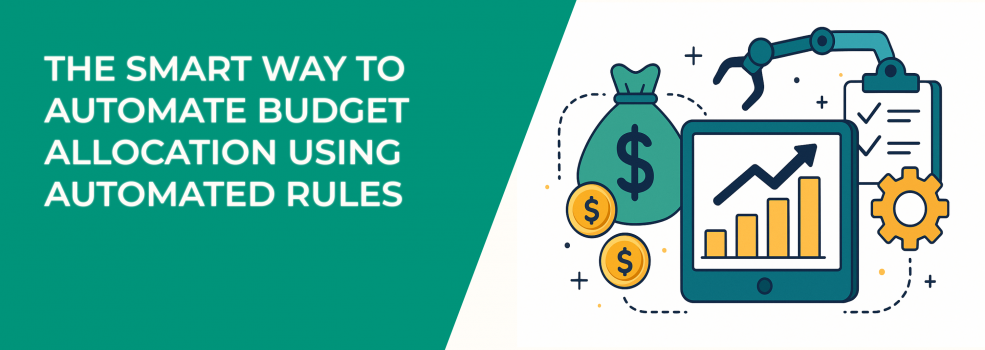If you’ve ever opened your Facebook Ads dashboard and asked yourself, “Am I really spending in the right places?” — you’re not alone.
Budget allocation is not a one-time decision. It shifts constantly, influenced by:
-
Creative fatigue,
-
Time-of-day trends,
-
Audience overlap,
-
And small, unpredictable shifts in auction behavior.
Unless you’re inside Ads Manager all day, every day, it’s nearly impossible to catch all these changes manually. That’s why leading advertisers are turning to automation — specifically, automated rules — to control ad spend more intelligently.
Let’s break down how this works, and how you can apply it effectively.
Why Manual Budgeting Can Fail Over Time
Manual control gives you a sense of ownership. You decide where every dollar goes. But in reality, this approach is slow and often reactive.
Consider how Facebook's ad platform works: its algorithm makes decisions in real time — bidding, learning, and adjusting thousands of times per second. You, as a human, simply can’t keep up.
For example: your campaign may perform best between 8 a.m. and noon. But if you don’t spot that trend until next week, you’ve already missed valuable opportunities.
By the time you manually move more budget to a top-performing ad set, performance might have already declined.
Automated rules solve this by acting instantly on performance data — without constant supervision.
What Are Automated Rules?
Automated rules are simple “if-this-then-that” logic you set within Meta Ads Manager. They allow you to create custom triggers that make real-time budget decisions based on actual campaign results.
Here are a few common examples:
-
If cost per purchase drops below $20, then increase budget by 15%.
-
If ROAS is under 1.5 for 3 consecutive days, then pause the ad set.
-
If frequency exceeds 4, then reduce budget by 10% to avoid audience fatigue.
You can apply rules to campaigns, ad sets, or individual ads, and you can build in multiple conditions to ensure they only trigger under the right circumstances.
Rules like these can prevent ad fatigue and protect performance over time. If you’re unsure whether high frequency is hurting your campaigns, this guide will show you how frequency capping helps fix ad fatigue.
Why Automation Helps Small Advertisers Most
There’s a common belief that automated rules are only for big teams or high budgets.
In reality, small businesses stand to gain even more from smart automation:
-
Tighter budgets mean less room for inefficiency.
-
Fewer team members means you can’t monitor every ad 24/7.
-
Faster decision-making gives you an edge over competitors reacting too late.
Even with a $50 daily budget, automated rules can help:
-
Avoid overspending,
-
Protect against poor performance,
-
And identify top-performing ads that deserve more spend.
If anything, smaller advertisers have more to gain from automation, not less.
How to Set Up Smart, Reliable Rules
Not all rules are helpful. Poorly constructed rules can interrupt high-performing campaigns or cause unstable budget swings.
To create automated rules that support rather than sabotage your performance, follow these principles:
1. Use Data-Driven Thresholds
Before setting any rule, understand your typical campaign performance. That includes:
-
Average cost per result,
-
Historical ROAS,
-
Conversion rate trends,
-
And seasonal patterns.
Avoid setting rules based on a good day or one campaign. Use 7-day or 14-day averages to determine what "good" looks like.
Example: if your average CPA is $22 and you want to scale profitably, a rule to increase budget only if CPA stays below $20 makes logical sense.
2. Keep Rules Focused and Non-Conflicting
Try to limit each rule to one clear purpose. Conflicting rules can fight each other — for example:
-
One rule increasing budget based on CPA.
-
Another reducing budget based on ROAS.
Instead, separate these goals. Have distinct rules for scaling and for pausing, and ensure they trigger under different, non-overlapping conditions.
3. Use Multi-Day Performance Windows
Single-day dips don’t mean your campaign is failing — but automated rules can mistakenly interpret them that way.
Set rules to trigger only when a condition is met consistently over time:
-
Trigger after 3 consecutive days of underperformance, not just one.
-
Use lifetime metrics or rolling averages to smooth out spikes and dips.
This filters out temporary fluctuations and makes your rules more reliable.
4. Scale Gradually to Avoid Disruption
It’s tempting to dramatically increase budget when an ad set performs well. But too much, too fast can shock Meta’s learning phase and lead to worse results.
Follow scaling best practices:
-
Limit budget increases to 10%–20% every 48–72 hours.
-
Monitor CPA and ROAS carefully after each increase.
-
Pause scaling if metrics deteriorate.
Example: if an ad set performs at $18 CPA, increase budget by 15% only if it stays under $20 for two days in a row.
Practical Example: Using Automated Rules to Scale Efficiently
Let’s say you’re launching a new product and running three ad sets:
-
Ad Set A has a cost per acquisition (CPA) of $18,
-
Ad Set B has a CPA of $24,
-
Ad Set C has a CPA of $30,
-
Your break-even CPA is $25.
Based on this performance, here’s how you could apply smart, automated rules:
-
Ad Set A: Since this is your best performer, set a rule to increase the budget by 15% every 48 hours, but only if the CPA stays below $20.
-
Ad Set B: This is close to your break-even point, so leave it unchanged for now. However, actively monitor frequency and ROAS to ensure performance doesn’t start to slip.
-
Ad Set C: Because it's running above your profitability threshold, set a rule to pause the ad set if CPA stays above $28 for three consecutive days.
These rules allow you to:
-
Scale what’s working.
-
Limit risk on underperforming ads.
-
Stay focused on metrics that matter — without constant manual intervention.
By letting automated rules handle these adjustments, you stay proactive while avoiding impulsive changes that could hurt your results.
Curious about how to scale spend more aggressively without hurting ROAS? Check out this article on the science of scaling Facebook ads without killing performance.
Tips for Managing Automated Rules Effectively
To make the most of automated budgeting, maintain clarity and control over your rule system. Here’s how:
-
Label rules clearly. Use descriptive names like “Scale A - CPA < 20 for 2d” or “Pause C - ROAS < 1.3 3d”.
-
Review rules monthly. Metrics shift over time. Adjust or retire outdated rules based on new performance data.
-
Test rules one at a time. Don’t build five rules at once. Run a single rule, monitor results, and optimize before layering others.
-
Be aware of context. Seasonal changes, promotions, or external events can skew results. Pause rules temporarily when needed.
When managed carefully, even a small set of well-structured rules can give you greater control, stability, and efficiency across your campaigns.
Automated rules are part of a bigger optimization system. If your ads still aren’t converting, it may not be your budget — here’s how to troubleshoot poor conversion performance in Facebook Ads.
Final Thoughts
Smart budget allocation isn't just about choosing the right campaign — it’s about adjusting quickly when things change. And they always do.
Automated rules let you manage your ad spend based on facts, not feelings. They give you time back, reduce guesswork, and help you scale with confidence.
But they require thoughtful setup, regular review, and a clear understanding of your metrics.
Start small: build a few simple rules, monitor how they perform, and refine your system as you grow.
Because when you're spending real money on Facebook and Instagram ads, the smartest move is to let data drive your budget.

